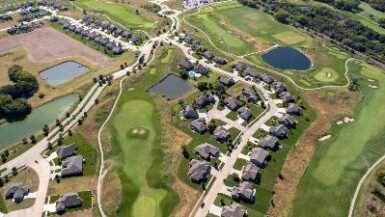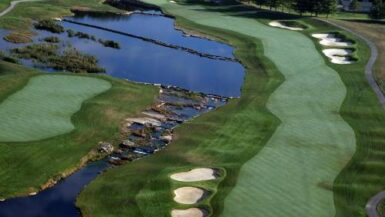
PEBBLE BEACH, CA – For the fourth consecutive day, June gloom hangs oppressively in the sky, so it’s no wonder golfers that prefer U.K. weather are doing so well on the leader board at the 119th U.S. Open at Pebble Beach.
Hopefully, blue skies and golden sunshine will return just in time for you, dear reader, to hit the links yourself, before heading to the tournament to watch the golf first hand. While choosing between golf courses in NoCal is akin to offering a starving man a menu, we chose some of our favorites recommendations to get you started.
Public Courses
Three planets orbit the sun that is Pebble Beach: Spyglass Hill, Poppy Hills, and the Links at Spanish Bay. You’ll be familiar with all of those from the AT&T, (formerly the Bing Crosby Clambake) played each year in February. While a trip to play these courses is an imperative, a golf bucket list trip – more so now because of Robert Trent Jones, Jr.’s excellent renovation of Poppy – because they can be necessarily completed as a package, let’s take a look at other public options off property.
Pasatiempo Golf Club, Santa Cruz
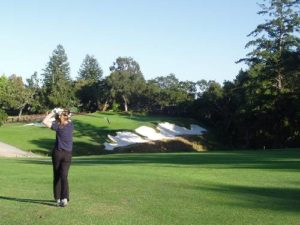
Pasa, as it’s known to its friends, is among the rarest of wonders – an Alister Mackenzie design that the public can play. The man who built both Augusta National and Cypress Point, both top five in America, possibly even the world, designed precious few public designs in America. Worse still, at the few public courses he did design, much of his work was erased by modern designers trying out their own ideas over Mackenzie’s canvas.
Happily, a Tom Doak restoration has re-polished Pasa back to its dazzling former self.
“Our mission statement at Pasatiempo was to restore the features of the golf course to the way they were on opening day in 1929 and not make any other changes,” said Doak in an earlier interview. “We put the bunkers back the way they were supposed to be based on the aerial photographs we had.”
An examination of some of the most iconic holes provides an excellent illustration of exactly how good Doak’s work is. At the par-4 16th, already frighteningly difficult because of the enormity of the false front, the greenside bunker now is much deeper and extends further out into the fairway. Already one of the most formidable greens in golf, poorly struck putts to run off the green, and the false front dooms many a player to a walk of shame, including Tiger Woods, who carded a triple bogey seven after hitting the green in regulation.
At the par-3 18th hole, perhaps the greatest par-3 finisher in golf excepting garden City, the trench bunker now guards the entire left side is a wasteland from which you’ll be lucky to have either a stance or a swing. The hurly-burly green seemingly has a herd of buffalo buried under it, so play your putt about ten feet right to left, even if you are pin high. And of course 10 and 11 are two of the best back-to-back holes in all of golf: brutishly long par-4s with thrilling all-or-nothing carries over yawning, hungry, ball-eating chasms.
Spanish for “passing time,” a round at Pasatiempo is like reuniting with a dear old friend. Mackenzie’s home sits to the left of the sixth fairway, and generations of golfers have posed for photo ops to pay homage to his memory.
TPC Harding Park Golf Course, San Francisco
Opened in 1925, this bastion of municipal public golf (owned jointly by the city and county) was San Francisco’s proper rejoinder to New York’s Bethpage Black, and San Diego’s Torrey Pines.
Similar in architecture to both Torrey and Olympic Club, also in San Francisco, (Willie Watson and Sam Whiting had a hand in designing both courses) Harding Park neither reaches the ocean, nor has many strategic angles of play. However, its rich history, length, greens with cunning micro-movement, and narrow, tree-lined fairways make it a strong candidate to handle the traffic of a major golf championship and provide a stern enough test for the pros. Also like Olympic Club, both courses sit on similar plots of land with the golf holes playing back and forth across terraced levels of a large hill. The most critical strategic difference between the two is that Oly has reverse camber to its fairways and Harding doesn’t, perhaps because it was easier for public players to get around more quickly.
The 2009 President’s Cup was a good dry run for the 2020 PGA Championship, the first time the PGA of America’s flagship event will be held on the west coast since Riviera in 1995, when Australian Steve Elkington claimed his only major victory. The course also hosted the 2015 Cadillac Match Play won by Rory McIlroy. With that match play pedigree, it should once again be a great host for the 2025 President’s Cup. Can a Ryder Cup be far off in its future?
Pacific Grove Golf Course, Pacific Grove, CA

Called the “Poor Man’s Pebble Beach,” the front nine approaches the Monterey Bay, hitting a strong peak with back-to-back par fives, while the back nine plays all along the cliffs overlooking the ocean. Five par-3s (two of which open the round) and three par-5s add up to a par of par of 70, but with so many short holes, players tend to have their best scoring round of the year here.
Private Clubs
Monterey Peninsula Country Club, Shore and Dunes Course, Monterey, CA
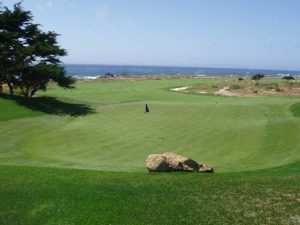
Perhaps only Winged Foot surpasses Monterey Peninsula Country Club when it comes to having two courses so equally strong, beautiful, and historic. Winged Foot may hold men’s major championships, but MPCC has miles of gorgeous Pacific shoreline, an iconic hazard along which so many greens and tees can precipitously cling. Set perfectly between Pebble Beach and Cypress Point, the Shore Course and the Dunes Course are as natural and idyllic a setting for golf as any on the planet.
Mike Strantz’s Shore Course is perhaps the finest design of his short, but incendiary career, it’s gorgeous par-3 11th hole being the last hole Mike completed before he died of oral cancer in 2005. His work was so well received, the club is now one of the host venues for the AT&T National. Strantz knew he was designing between Pebble and Cypress, cheek and jowl with Mackenzie, his favorite designer of all, and he delivered a course in complete harmony with both of those designs, as well as the natural surroundings and terrain.
Not to be outdone by his former design associate, Tom Fazio renovated the Dunes Course, adding both difficulty and beauty. Like the Shore course and Cypress Point, the Dunes course is a transitional routing. Starting in the forest, you play through several holes of dunescape – 9, 10, 11, and 12 – then reach the ocean for holes 13 through 15, before heading back inland and finishing in the forest.
California Golf Club of San Francisco, San Francisco

“I heard it’s the best restoration in golf history, so let me know what you think,” suggested the editor-in-chief of one of the two biggest magazines in golf. His sources were not far off. Kyle Phillips did his best to channel Alister Mackenzie and A.V. Macan in bringing back Cal Club, as it’s known to its friends, back to international prominence.
Olympic Club may host majors, but with far more tumultuous terrain, wilder greens, and breathtaking views of the city on nearly every tee box, Cal Club has become the haute cuisine of the golf world, every bit the equal of Oly or San Francisco Golf Club, both of which make perennial appearances atop everyone’s rankings lists.
It’s impossible to overstate Phillips’s success at Cal Club. He completely eliminated a frightening nematode problem – one of the most horrifying things that can happen to a golf course, in some cases even a death sentence. In doing so, he rebuilt every green so that it looks as though it were restored to its exact Golden Age specifications, even though several of them are Phillips originals. He also had to re-route wholesale sections of the front nine and build two completely new holes, all the while endeavoring to make them look and play like they were there since A.V. Macan and Alister Mackenzie’s time.
Olympic Club (Lake Course), San Francisco
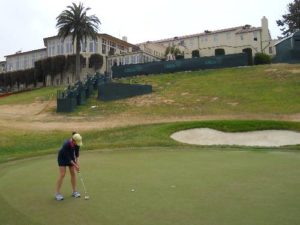
The host of five previous U.S. Opens will host its first PGA Championship in 2028. Reverse camber and “trees, trees, tress…about 40,000 trees” are the main defenses at Oly, as it’s called colloquially. It was no less a personage than Art Spander, the great writer for the Oakland Tribune and the San Francisco Examiner who lamented the trees, saying “They even lose golf balls in them, and when a wind storm comes through, you’ll find 50-100 balls have blown down out of those cypress branches.”
The reverse camber of Olympic Club tests both distance and accuracy off the tee; it acts as a restrictor plate on driving distance. It’s no wonder ball strikers win and long bombers go home early. Of the past Open champions – Webb Simpson, Lee Janzen, Scott Simpson, Billy Casper, and Jack Fleck, none of them had the 54 hole lead.Moreover, the opening stretch of six holes is so difficult, USGA Executive Director Mike Davis opined pre-tournament that “any player who’s 2-over or better is doing extremely well.” Simpson took home the trophy with a 1-over 281 aggregate score.
BONUS: The Meadow Club, Fairfax
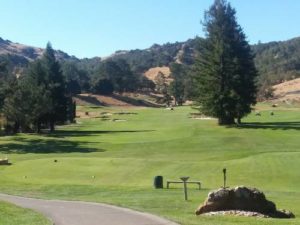
It may be over an hour drive north of San Francisco and two full hours from Pebble Beach, but Alister Mackenzie and Robert Hunter first collaborated at this gorgeous stretch of burnished fescue in the valley beneath forbidding Mount Tamilpaus. It proved the impetus for a long, storied, and fruitful career for them both.
Meadow Club is also at the vanguard of two other important sustainability movements in golf – the conservative use of water and the sharing of adjacent fairways with no rough. The grounds crew there, headed by Sean Tully, one of the smartest in the business, understand that not everything has to be green. Droughts force the club to use less water. Fairways are biscuit brown, like you find at the Open Championship, perfect for firm, fast conditions.
Moreover, by shaving all the rough between fairways, not only do balls roll into bunkers more easily, but wider fairways translate to more playing angles for golfers. In particular the side-by side par-5s at 13 and 15 share an Elysian Fields-like double fairway, similar to what you’d find at St. Andrews or Old Town Club. Goofy slices may end up in bunkers on the wrong hole.
“What? No San Francisco Golf Club?” you ask. Don’t fret: We come back next year for the PGA at Harding Park. You’ll get SFGC then, along with a different crop of other courses to try out as well.


